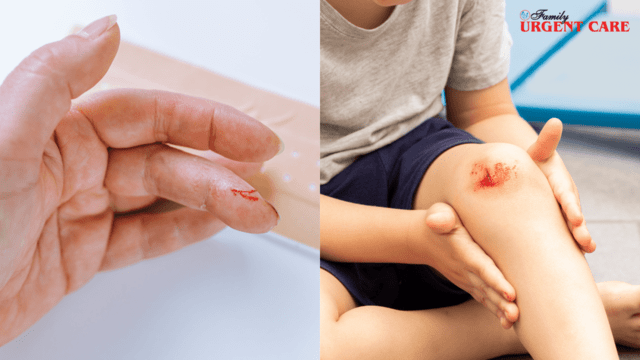Cuts and wounds are par for the course, as life’s full of these tiny accidents waiting to happen. You might be chopping veggies for your lunch, and then bam! You’ve cut your finger. Or maybe your child is playing in a playground and, a moment later, tripped over a stray stone and skinned their knee due to the fall.
Now you might be wondering whether you or your child has a cut and if it needs medical attention. What steps you can take to prevent infection? And how do you differentiate between a cut and a laceration?
No rush! In this blog, you’re about to explore some key differences between the two types of wounds and also find out the signs and symptoms that need urgent care.
The Main Difference Between A Cut vs Laceration Wound
| Cut | Laceration | |
| Definition | A type of wound with clean and sharp edges | A type of wound with ragged, irregular edges |
| Causes | Caused by a sharp object such as a knife, glass or scissors. | Caused by friction or abrasion mostly due to fall or impact or machinery. |
| Severity | It can be mild to severe depending on the depth of the wound | More severe as the jagged edges need medical attention to heal properly |
| Types | Superficial cuts, deep cuts, avulsions, puncture wounds | Tear, split laceration, stretch laceration, cut laceration |
What Are The Signs And Symptoms?
Cuts are easy to diagnose if the view is not obscured with blood due to the sharp, clean edges. The common symptoms of a cut or laceration are as follows:
- Bleeding (depends on the severity of the wound)
- Inflammation in the wound which includes redness, pain, swelling and sometimes fever)
- Exposure of underlying tissues (in deep cuts)
- Damage to muscle or bone if the cut or laceration is deep
- Scarring might occur
Note: Do not self-diagnose but seek immediate medical attention at urgent care for proper diagnosis, wound evaluation, cleaning and treatment. You can walk into the Family Urgent Care clinic without booking an appointment to get prompt treatment from our experienced healthcare providers.
What Are The Types of Cuts or Laceration?
There are several types of cuts based on the severity of the injury, such as:
- Superficial cuts only damage the outermost layer of the skin, the epidermis and occur due to minor injuries.
- Deep cuts: Damage occurs in the underlying tissues beneath the skin, such as muscles or even bones, due to injury from sharp objects like broken glass or knives.
- Avulsions are when a small part of the skin is torn away due to a severe injury or accident. They require prompt treatment at an emergency care facility.
- Puncture wounds: Can be caused by sharp objects like needles or iron nails.
- Incised wounds: These are often caused by sharp objects that penetrate the skin through a slicing motion.
Some common types of laceration wounds include:
- Tear– In this type, soft tissue injury occurs when the skin comes in and rubs against a heavy blunt instrument like a cricket or baseball bat with impact.
- Split laceration: In this type, the skin splits when it is crushed between two hard objects. The hard object can be a bone underneath the skin and the ground.
- Incised laceration: It is the same as an incised cut, as the wound is clean with sharp edges.
- Stretch laceration: In this type, laceration occurs due to overstretching of skin. As a result, the skin layer protrudes like a flap. e.g., machine or vehicle injuries.
When Should You Seek Urgent Care For Cuts or Laceration?
You might be wondering whether your cut might need urgent medical care or not. Well, if it is a superficial cut that is not bleeding, then you might not need to visit an urgent care facility for medical attention. You can clean it at home with an antiseptic, apply an antibiotic ointment and cover it with a gauze.
However, seeking urgent care is necessary for prompt first aid if you encounter any of the following scenarios.
- You can see exposed tissue after a cut or laceration with some bleeding that’s not life-threatening.
- If there’s dirt or any foreign object, even after cleaning your wound.
- If the wound is located on the face, joints, chest or genitals.
- The cut is over 1/4th inch, and you can see the tissue beneath. Your healthcare provider might take a decision to close the wound through stitches if needed.
- The wound has jagged or uneven edges, or there’s a high risk of scarring or infection.
- You notice redness, swelling, warmth, persistent pain and a discharge from the site of the wound.
- If the wound is due to an animal or insect bite, rusted nails, falling on the road or rocks, it’s better to seek urgent care.
A word of caution! If the wound is too deep and is bleeding even after applying pressure for 10 to 15 min, you might need to visit an emergency care facility without any delay.
How Will the Doctor Treat Your Laceration Wound?
Once you visit an urgent care clinic for the treatment of a laceration or cut, here are a few steps the urgent care provider will follow:
- Examine the wound to assess the severity
- Then decide if the wound needs to be stitched or any other minor procedure is required.
- Ask about medical history, including allergies, clinical conditions, or any current medications.
- Discuss different options for closing the wound.
- Counsel you about the procedure if stitches are necessary
If stitches are needed for the closure of the wound, the doctor will take the following steps:
- Firstly, the healthcare provider stops the bleeding by applying pressure using a gauze or bandage.
- For minor lacerations local anesthesia is given that will numb the affected area while for deep lacerations sometimes general anesthesia is required to close the wound.
- In cases of minor lacerations, once the area is anesthetized, the doctor carefully stitches the wound area.
- After the wound is carefully closed, the provider will apply an antiseptic, and cover it with gauze and a bandage.
- The patient might need a tetanus shot if an animal bites a person or the person has a cut or laceration due to a roadside accident.
At-Home Care For Lacerations Or Cuts
If you have a superficial cut that does not involve fat or muscle, is less than ½ inch, and is not bleeding heavily, you can manage it at home without visiting urgent or primary care. However, if you’re unsure how to treat the wound at home, getting help from a healthcare provider is better.
Keep a close eye on any signs or symptoms, such as redness, swelling, or discharge from the wound area. If you notice any of these signs, your wound may become infected and need urgent care.
Visit Family Urgent Care For Cuts or Lacerations
You can visit the Family Urgent Care clinic immediately for non-life-threatening cuts or lacerations and leave the rest to our trained medical staff. The healthcare provider will assess your wound and provide the right treatment to ensure a prompt recovery. If you cannot visit the clinic, you can even book a telehealth video or phone appointment to consult our team quickly.
FAQs
How long does it take for a laceration or a cut to heal?
The healing of a laceration wound depends on various factors such as the size, depth and location of the wound. Generally, superficial cuts or lacerations may take about one to two weeks. However, in case of deep cuts or lacerations, the wound healing time may vary from 6 to 8 weeks.
What is the difference between a skin tear and a laceration?
A skin tear looks like a cut or scrape and is often caused by friction when the skin comes in direct contact with another object with impact and separates the skin layers. However, a laceration is quite different as it has jagged or irregular edges caused by trauma, force or shear.
How do I know that my wound is infected?
If you notice these symptoms from the site of the wound, your wound has likely become infected. In such cases, it is necessary to visit a healthcare provider right away.
- White or yellow cloudy discharge
- Increased pain and swelling after 48 hours of injury
- A yellow crust is formed on the wound instead of brown.
- Increased redness around the wound
- Presence of fever, i.e., 100 F
What are some possible complications of untreated lacerations or cuts?
A laceration wound or cut can cause serious complications if it is not managed properly or left untreated. Some of these include:
- Excessive blood loss leading to shock
- Bacterial infections
- Tetanus infection
- Neurovascular injury
- Scarring

